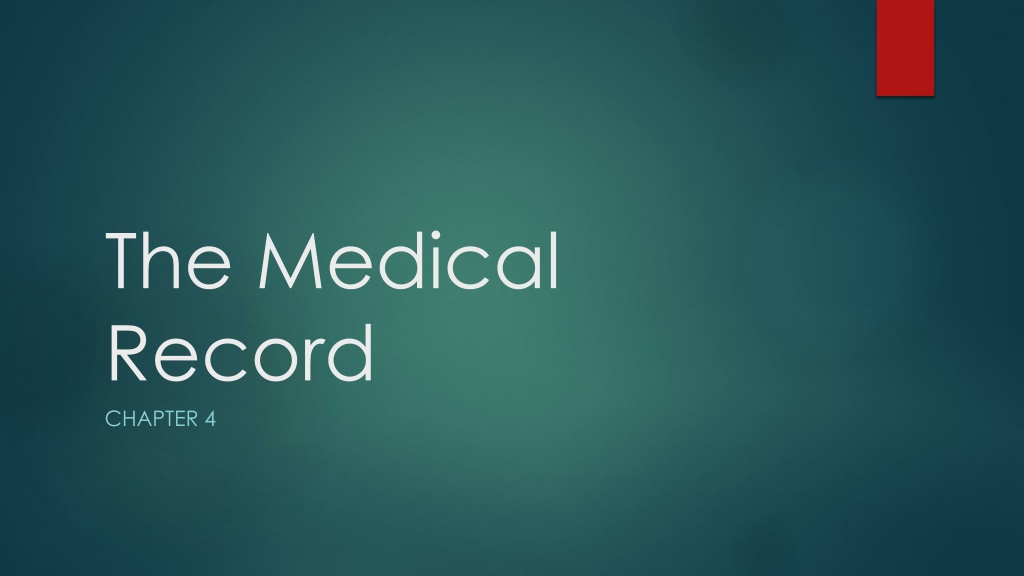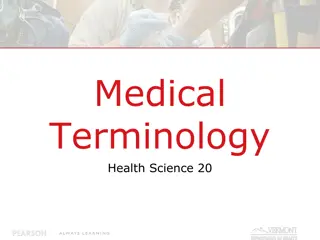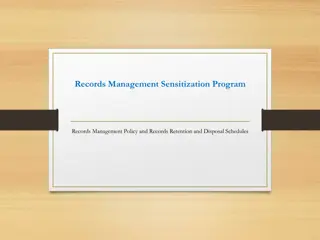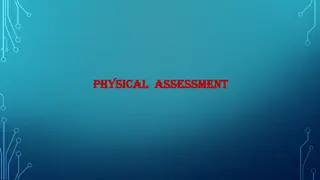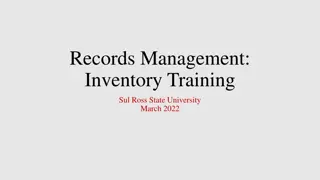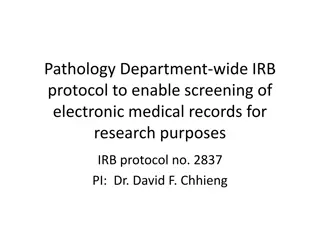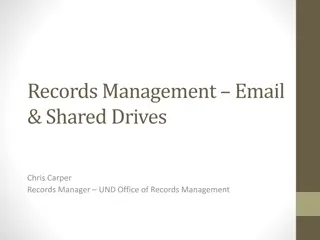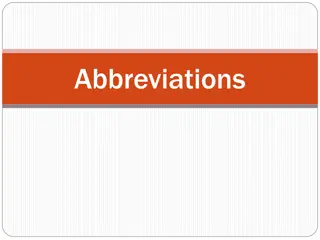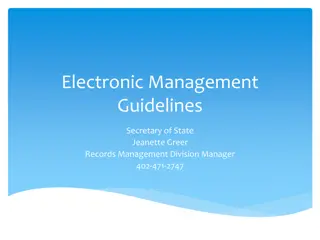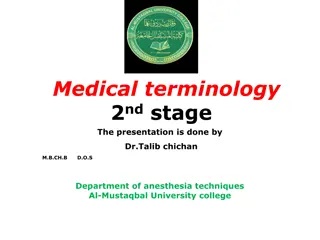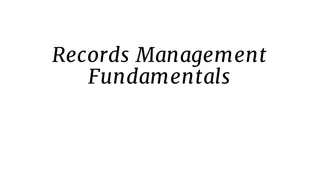Understanding Medical Records: History, Physical Examination, and Abbreviations
Medical records play a crucial role in documenting a patient's medical history and findings from physical examinations. The history and physical (H&P) document includes subjective information from the patient and objective observations by the examiner. The history (Hx) record covers personal medical history, including past injuries, illnesses, and family history. Abbreviations like CC (Chief Complaint) and PMH (Past Medical History) are used to efficiently document patient information. The physical exam (Px or PE) document details the physical examination findings and diagnostic test results. Understanding these components is essential for healthcare professionals to provide comprehensive care.
Download Presentation

Please find below an Image/Link to download the presentation.
The content on the website is provided AS IS for your information and personal use only. It may not be sold, licensed, or shared on other websites without obtaining consent from the author. Download presentation by click this link. If you encounter any issues during the download, it is possible that the publisher has removed the file from their server.
E N D
Presentation Transcript
The Medical Record CHAPTER 4
History and Physical H & P Document of medical history and findings from physical examination Includes: Subjective information History obtained from patient including his/her personal perceptions Objective Information Physical facts and observations made by an examiner
History (Hx) Record of the patient s personal medical history including past injuries, illnesses, operations, defects, and habits Includes: chief complaint, history of present illness, past history, family history, occupational history and review of systems
History (Hx) Abbreviations CC Chief Complaint or Brief description of why patient is seeking care PI or HPI Present Illness/History of Present Illness Notation of duration and severity of complaint How bad is it? How long have they had it? Sx symptom Evidence of illness that the patient reports c/o complains of
History (Hx) Abbreviations (continued) PH, PMH Notation of surgeries, injuries, physical defects, medications, allergies UCHD usual childhood diseases NKA no known allergies NKDA no known drug allergies Past History, Past Medical History
History (Hx) Abbreviations (continued) SH recreational interests, hobbies, use of tobacco/drugs OH Occupational History work habits that may involve work related risks ROS or SR Review of Systems, Systems Review questions related to function of the body systems HEENT head, eyes, ears, nose, throat Social History
Physical Exam (Px or PE) Document of physical examination of a patient including notations of positive and negative findings Includes: results of diagnostic testing Sign objective evidence of disease
Physical Exam Abbreviations HEENT PERRLA NAD WNL head, eyes, ears, nose, throat pupils equal, round and reactive to light and accommodation no acute distress, no appreciable disease within normal limits
History and Physical Impression (IMP) Diagnosis (Dx) Assessment (A) evaluation of all subjective and objective information Rule out (R/O) a differential diagnosis noted when one or more diagnoses are suspect requires further testing to verify or eliminate each possibility identification of a disease or condition after
History and Physical (continued) PLAN, RECOMMENDATION, or DISPOSITION outline of the treatment plan designed to remedy the patient s condition, which includes instructions to the patient, orders for medications, diagnostic tests, or therapies
Problem Oriented Medical Record (POMR) Health record with focus on patient s problem Information organized for access at a glance Documents thought processes of provider Consists of four sections: Database Problem list Initial plan Progress notes
Common Patient Care Abbreviations difficulty breathing SOB Treatment or transfer Tx, Tr temperature, pulse, respiration, blood pressure T, P, R, BP = VS or vital signs increase decrease degree or hour pound or number sign #
Error Prone Abbreviations and Symbols Medical errors caused by illegible entries and misinterpretations have led health care agencies, such as the Joint Commission on Accreditation of Healthcare Organizations (JCAHO), to require that medical facilities publish lists of authorized abbreviations for use by all personnel, including a list of those unacceptable.
Error Prone Abbreviations and Symbols (continued) q. d mistaken for q.i.d when the period after the q is sloppily written to look like an i spell out daily q.o.d. every other day mistaken for q.d when the o is mistaken for a period spell out every other day every day
Error Prone Abbreviations and Symbols (continued) DC, D/C mistaken for discontinue when followed by medications prescribed at the time of discharge. Still used without any difficulties spell out discontinue or discharge >, < greater than, less than mistaken for each other spell out discharge, discontinue
Error Prone Abbreviations and Symbols (continued) AS, AD, AU OS, OD, OU mistaken for each other spell out SC or SQ mistaken for SL (sublingual), or 5 every . spell out "subcutaneously or use Sub-Q left ear, right ear, both ears left eye, right eye, both eyes subcutaneous; ok to use SubQ
Videos of Taking a pt Hx Taking a patient history for Medical Assistants By Del Mar (1st 8 min) https://www.youtube.com/watch?v=lqA8kPgfDio Taking a patient history (8 min) https://www.youtube.com/watch?v=NW-ZRo6GJnA Clinical History Taking (20 min) https://www.youtube.com/watch?v=gsjKcQUsQY8
Commonly Used Abbreviations (quiz material) Hx (history), Sx (surgery or symptom, S/sx (sign and symptom), CC (chief complaint). SOAP (subjective, objective, assessment, plan) q.d. (daily); q.o.d. (every other day); q.i.d. (four times a day), t.i.d. (three times a day), prn (as needed), ac (before meals), hs (hour of sleep or bedtime), po (by mouth), NPO (nothing by mouth) AS (left ear), AD (right ear), AU (both ears), d/c or dc (discontinue or discharge). SC or SQ (subcutaneous), IM (intramuscular) /a (before), /p (after), /c (with), /s (without), VS or vs (vitals), tx (treatment or transfer), dx (diagnosis), pt (patient) RTO (return to office), f/u (follow up)
Commonly Used Abbreviations (quiz material) gtt (drip), mg (milligram), g (gram), kg (kilogram), L (liter) WBC (white blood cells), RBC (red blood cells), HGB (hemoglobin), HCT (hematocrit), Na (sodium), K (potassium), BMP or CMP (basic or comprehensive metabolic panel), CBC (complete blood count), PT/INR (protime/international normalized ratio) WNL (within normal limits), R/O (rule out) CP (chest pain), HTN (hypertension), CHF (congestive heart failure), CABG (coronary artery bypass graft), CA (cancer), ETOH (alcohol), SOB (shortness of breath), HEENT (head, eyes, ears, nose, throat). 1400 (2pm), 1700 (5pm), 2100 (9pm) L (left), R (right), B (bilateral).
